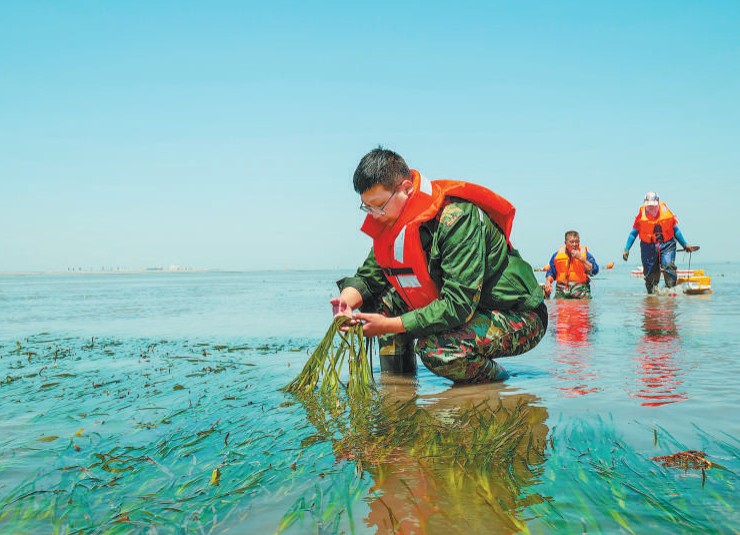Coastal city in N China restores marine ecology with underwater seagrass meadows – People’s Daily

Restoration of Caofeidian Seagrass Beds: A Sustainable Development Initiative in Hebei Province
Introduction
Off the coast of Tangshan in Hebei province, north China, a significant ecological restoration project is underway in Bohai Bay. The restoration of seagrass beds, particularly the Caofeidian seagrass bed—the largest continuous single-species seagrass habitat in China covering over 4,400 hectares—is contributing to marine ecosystem recovery and aligns closely with the United Nations Sustainable Development Goals (SDGs), especially SDG 14 (Life Below Water) and SDG 15 (Life on Land).
Ecological Importance of Seagrass Beds
- Stabilize seabed and prevent sediment erosion
- Provide critical habitats for diverse marine organisms
- Support biodiversity and marine life breeding grounds
Challenges and Degradation
Prior to restoration efforts, the Caofeidian seagrass beds experienced degradation due to:
- Frequent fishing activities such as trawling and clam digging
- Damage to seagrass and disruption of benthic communities
- Reduction in living space for seagrass and overall ecosystem imbalance
Restoration Efforts and Techniques
Initiated in 2019, the Caofeidian seagrass bed restoration project employs a comprehensive, multi-faceted approach to rehabilitate the ecosystem, supporting SDG 14 and SDG 13 (Climate Action) by enhancing coastal resilience:
- Removal of abandoned fishing nets and traps
- Restriction of vessel access to minimize disturbance
- Improvement of nearshore water quality through monitoring and remediation of 283 wastewater discharge points
- Manual transplantation of seagrass seedlings coordinated precisely with tidal patterns
- Development of a seed-ball method embedding seeds in soil balls to prevent seed displacement
- Differentiated restoration strategies based on natural recovery potential, including passive restoration and intensive interventions such as sediment remediation and plant relocation
Technological Integration
The project incorporates smart offshore monitoring platforms to track seagrass growth and environmental conditions, enhancing data-driven decision-making and sustainable management practices, contributing to SDG 9 (Industry, Innovation, and Infrastructure).
Outcomes and Impact
After six years of continuous effort, the restoration project has achieved significant ecological improvements:
- Increased vegetation coverage and flourishing seagrass meadows
- Growth in the number of large benthic species from 60 to 111
- 42.3% year-on-year increase in biodiversity index
- Creation of vital habitats, migration corridors, and breeding grounds for marine life
These outcomes contribute directly to SDG 14 by promoting the conservation and sustainable use of oceans, seas, and marine resources.
Conclusion
The Caofeidian seagrass bed restoration project exemplifies a successful ecological restoration initiative that integrates scientific innovation, community involvement, and sustainable management. It supports multiple Sustainable Development Goals by enhancing marine biodiversity, improving ecosystem services, and fostering resilience against environmental challenges.
1. Sustainable Development Goals (SDGs) Addressed or Connected
- SDG 14: Life Below Water
- The article focuses on marine ecosystem restoration, specifically seagrass beds, which are vital for marine biodiversity and ecosystem health.
- SDG 15: Life on Land
- Although primarily marine-focused, the restoration efforts involve coastal and nearshore environments, linking to terrestrial ecosystem conservation and restoration.
- SDG 6: Clean Water and Sanitation
- Improvement of nearshore water quality and remediation of wastewater discharge points are mentioned, which relate to water quality management.
- SDG 13: Climate Action
- Seagrass beds act as carbon sinks, contributing to climate mitigation efforts, implied through ecosystem restoration benefits.
2. Specific Targets Under Those SDGs Identified
- SDG 14: Life Below Water
- Target 14.2: Sustainably manage and protect marine and coastal ecosystems to avoid significant adverse impacts, and take action for their restoration.
- Target 14.5: Conserve at least 10% of coastal and marine areas.
- SDG 15: Life on Land
- Target 15.1: Ensure the conservation, restoration, and sustainable use of terrestrial and inland freshwater ecosystems and their services.
- SDG 6: Clean Water and Sanitation
- Target 6.3: Improve water quality by reducing pollution, minimizing release of hazardous chemicals and materials, and substantially increasing recycling and safe reuse.
- SDG 13: Climate Action
- Target 13.2: Integrate climate change measures into national policies, strategies, and planning.
3. Indicators Mentioned or Implied to Measure Progress
- Marine Biodiversity Indicators
- Increase in the number of large benthic species (from 60 to 111) indicates biodiversity improvement.
- Biodiversity index increase by 42.3% year on year measures ecosystem health and species diversity.
- Seagrass Coverage and Health
- Vegetation coverage increase and restoration of sparse/barren patches are used to assess ecosystem recovery.
- Area of seagrass habitat (over 4,400 hectares) as a spatial indicator of restoration scale.
- Water Quality Indicators
- Remediation of 283 wastewater discharge points and monitoring of wastewater outlets imply measurement of pollution levels and water quality improvement.
- Restoration Effort Metrics
- Number of restored seagrass seedlings and seed-ball planting success rates as operational indicators.
4. Table of SDGs, Targets, and Indicators
| SDGs | Targets | Indicators |
|---|---|---|
| SDG 14: Life Below Water |
|
|
| SDG 15: Life on Land |
|
|
| SDG 6: Clean Water and Sanitation |
|
|
| SDG 13: Climate Action |
|
|
Source: en.people.cn








